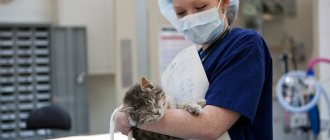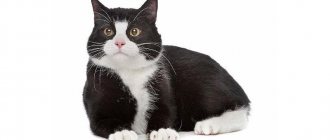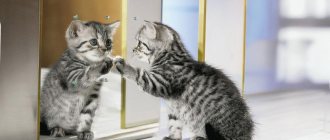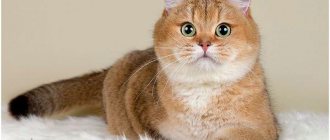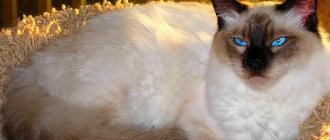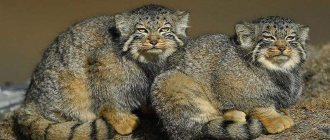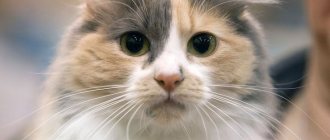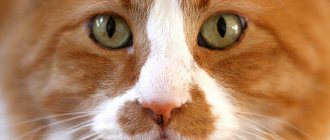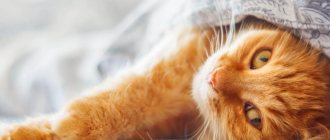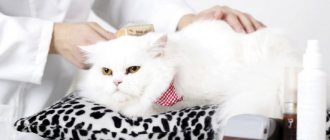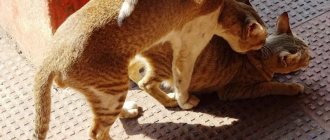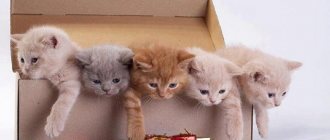A cat's body weight is of greater importance for their normal development and health. Like humans, felines can also have problems with weight (overweight or, less commonly, underweight). Obesity is a fairly common problem that occurs among domestic cats. In addition, you need to know how much the cat weighs in order to calculate the required dose of medications, the volume of food portions, also for traveling with an animal. How to determine the weight of a cat? This article will help answer this question.
Weight is determined by various factors:
- Breed.
- Availability of sterilization/castration.
- Floor.
- General health.
- Lifestyle (activity, diet).
- Age.
- Genetics.
© shutterstock
The biggest and fattest pet
Cat Katie
The first place among the fattest pets is taken by the cat Katie from Russia. At 5 years old she weighs 23 kilograms. The cat has a girth of 70 centimeters.
One can only envy her diet: two fish in the morning, a piece of meat in the evening, food, milk, grass in the afternoon. Katie can eat two sausages in a minute. The cat became so big because of its owner: she was tired of cat parties and overdosed the medicine.
She doesn’t want to limit the cat’s food because she feels sorry for her. Apparently, it’s not a great pity – such weight won’t lead to anything good.
Himmy the Cat
A large wool bag from Australia weighed 21.3 kilograms. His girth was 84 centimeters.
Himmi was very lazy, moved little and ate a lot. At the age of 10 years, the cat could not even move on his own and died from problems with the respiratory system.
After this, the Guinness Book of Records canceled the title of the fattest cat, so that owners would not overfeed their pets.
The weight of the fattest cats in descending order:
- Katie – 23 kg, Russia.
- Himmi – 21.3 kg, Australia.
- Snowball – 20 kg, Scotland. Spice – 20 kg, USA.
- Tulle – 19.5 kg, Denmark.
- Meow – 18 kg, USA.
- Elvis - 17.5 kg, Germany.
- Otto – 16 kg, USA. Bond – 16 kg, Finland.
- SpongeBob – 15.5 kg, USA.
- Lobster – 14 kg, Australia.
Estimating the weight of cats and cats
When assessing live weight, the season of the year and the physiological state of the pet should be taken into account. Cats that regularly walk outside, like wild animals, gain weight in the winter because their physiology is tuned to heat from the inside, due to the fat accumulated from excess food consumption.
Be sure to read:
3 cat breeds with different eye colors (heterochromia)
In the summer, cats lose a lot of weight because they eat little. This is how the animal is protected from overheating. During sexual arousal, cats lose weight.
For cats, the season plays a role, but to a lesser extent than for males. But pregnancy leaves its mark: the female sharply gains weight due to embryos and amniotic membranes. After lambing and feeding the cubs for a month and a half, a cat can lose a lot of weight.
Cat underweight
Deficiency occurs in the following cases:
- Unbalanced diet or insufficient feed. It is necessary to monitor whether the pet is eating enough. Use ready-made feed of premium class or higher.
- Lactation - a nursing mother needs three times more calories than a single cat. Therefore, during this period they practice ad libitum feeding with energy-rich foods. The best choice of ready-made dry food for kittens and adolescents.
- Obstruction or obstruction of the intestines due to blockage by trichobezoars - hairballs soaked in semi-digested food. Prevent regular brushing. the use of specialized feed that prevents the formation of stones, the use of malt paste.
- High worminess.
Average weight of a cat
If the cat looks graceful, its coat is shiny, and its hours of sleep alternate with periods of high activity, then it is healthy and has an optimal weight. In this case, you don’t have to weigh it unless necessary.
Overweight cat
In healthy animals, excess weight is temporary. For example, the housewife was cutting up fish or meat and the purr ate to his fill. Obesity indicates the onset of the disease.
Castrati suffer the most from excess weight. They do not walk on the street, spend their entire lives in an apartment, and have no sexual motivation. A radical measure to combat excess weight is the use of specialized food for sterilized cats. They contain a lot of fiber, which causes a feeling of fullness before the animal has time to consume extra calories.
Be sure to read:
How to find out how many months a kitten is, learning to determine the correct age of the animal
Specialized foods have also been developed for obese, uncastrated pets. Excess weight can be caused by chronic diseases and old age. In such situations, you should contact your veterinarian.
Longest Maine Coon
Stewie
Stewie the cat from America is considered the longest cat.
Its size was 123.19 centimeters from the last hair of the tail to the nose. He was sick with cancer, soon after a course of chemotherapy he began to deteriorate sharply, and the cat died at the age of 8 years.
The owner called him the kindest and most affectionate cat, whose love was enough for everyone. This character is usually found in all Maine Coons.
Lobster
Maine Coon Omar, four years old, from the UK is currently considered the longest cat . From nose to tail, his length is 120 cm.
Omar prefers to eat raw kangaroo meat.
The cat does not like too much attention : when journalists and a large number of people began to take an interest in him, he became lethargic and sad. The photo shows the cat Omar and his owner.
List of the longest cats in descending order:
- Stewie – 123.19 cm, USA.
- Leo – 121.9 cm, USA.
- Lobster - 120 cm, Australia. Bond (Pikkis) – 120 cm, Finland.
- Ludo - 118.33 cm, UK.
How much should a cat weigh depending on age and breed: table
Animals of different sexes, breeds and ages weigh differently. Indicators of average body weight in grams and permissible deviations are shown in the tables:
Mongrel cats
| Age, months | Outbred | |
| males | females | |
| At birth | 105±25 | 85±15 |
| 2 | 1300±200 | 1050±250 |
| 4 | 2750±450 | 2500±300 |
| 6 | 3250±550 | 2700±600 |
| 8 | 3400±600 | 3000±700 |
| 12 | 4250±750 | 3500±1000 |
British
| Age, months | British | |
| males | females | |
| At birth | 105±35 | 100±40 |
| 2 | 1350±350 | 675±225 |
| 4 | 3000±900 | 2100±400 |
| 6 | 4200±120 | 2950±550 |
| 8 | 4750±1200 | 3250±750 |
| 12 | 5750±1250 | 3850±750 |
Maine Coon
| Age, months | Maine Coon | |
| males | females | |
| At birth | 140±20 | 120±20 |
| 2 | 1400±200 | 1250±250 |
| 4 | 3400±400 | 3150±450 |
| 6 | 4150±350 | 3600±400 |
| 8 | 5300±800 | 4350±550 |
| 12 | 7100±1700 | 6400±1900 |
The table shows that males are larger than females throughout their development. The weight of newborns depends on the number of kittens, and the intensity of development in the first weeks of life depends on the milk production of cats. A standard has been developed for each breed, which specifies the minimum and maximum limits.
The health status of the pet is assessed based on whether the live weight corresponds to the reference weight. For adult animals, it is not so much the live weight that matters, but rather the condition of nutrition.
The tallest Savannah cat
Arcturus
His height is 48.4 centimeters. He is young enough, there is a possibility that he will become even taller after some time .
Arcturus consumes 1 kilogram of food per day. From his fame, the owners earned a lot of money, which they used to develop their animal shelter.
Recently, he and his neighbor Cygnus (the cat with the longest tail) disappeared after a house fire. The owners hope that the pets are alive and will be found soon.
Trouble
Trouble, who lived in America, reached a height of 48.26 centimeters and was considered the tallest cat for a very long time.
He is a cross between a domestic cat and a wild African serval. Cats of this breed can grow up to 60 cm in height and weigh up to 15 kg. But Trouble is not that heavy: he weighed only 9 kilograms.
He doesn't like cat food and only eats lightly cooked raw rabbit and beef. The cat was very active and loved various games. Died in 2012. The photo shows a skinny Trouble.
How many cat breeds are there?
Today there are more than 200 breeds. We are presented with a unique opportunity to see with our own eyes so many different breeds of animals that our ancestors could not see. The direct purpose of the cat was lost over time. Mice and rodents are no longer the problem they once were. Now the vast majority of people live in megacities, in apartments. Apartment owners rarely encounter “uninvited guests,” and residents of private houses easily destroy them using arsenic or mousetraps.
Therefore, pets are bought more for the soul. Parents allow their children to have cats and dogs so that the children learn responsibility and learn to take care of someone other than themselves. And for those who live alone, pets become real companions and friends.
Giant liger Hercules
The cat named Hercules is a cross between a male lion and a female tiger. He is not a domestic cat, but lives with a person and loves his owner very much.
How much does this huge cat weigh? The body weight of this liger is 408.23 kilograms! This is normal for Hercules; he is not obese. He eats 9 kilograms of meat a day.
He could eat about 40 kilograms, but then the weight could reach 700 kilograms. Hercules would not be able to move due to obesity.
This is a very large, agile and active cat. He loves to run and is an excellent swimmer. From the nose to the end of the tail, the length of the liger is 3 meters 70 centimeters. Its height is 1.86 meters. The maximum speed of this cat is 80 km/h.
Hercules has tiger stripes on his body, but a lion's face. His mane has not grown. For many years it has been considered the largest representative of the cat family . There are only 25 ligers in the world. The photo shows Hercules with his owner.
The liger named Sudan is taller than Hercules and is 4 meters long.
Places 10 to 6
This rating is quite arbitrary, since the largest domestic cats do not always differ so significantly in size from their other brothers, who did not find a place in the top. This is especially true for females, who by nature are always smaller than males.
10. Kurilian Bobtail. The hit parade of big cats opens with a large, handsome Kurilian Bobtail. The weight of an adult male ranges around 6.8 kg, females - from 3.5 to 5 kg. This breed was bred on the Kuril Islands and transported to the mainland at the end of the 20th century. A characteristic feature of bobtails is their short tail. These graceful big cats can even compete with dogs in terms of affection for their owner and intelligence. Kurilian Bobtails are usually friendly and love attention.
Kurilian Bobtail
9. Chartreuse. Chartreuse is a large cat whose breed is recognized throughout the world, except Britain. They began to be bred in the French city of Chartres, where the name of these large cats comes from. In the Middle Ages they were called cat-dogs - these animals were so muscular, strong and smart. Males weigh 6-7 kg, females - 5-6. Despite their attachment to their owner, Chartreux are not very talkative and often only purr.
Chartreux are large cats, the breed of which is recognized throughout the world, except Britain.
8. Pixie bob. A domestic cat that is almost identical in appearance to the bobcat is the pixie bob. The breed was artificially bred in the USA and is translated as “short-tailed elf.” You should not take the external severity and severity of these cats seriously: pixie-bobs love tenderness, are very tactful and unobtrusive. They do not reach the size of a lynx, but belong to the list of large cats weighing from 5 to 7.7 kg.
Pixie bob. A domestic cat that is almost identical in appearance to the lynx is the pixie bob.
7. Norwegian forest. The hardiest cat in the world, adapted to harsh conditions, is the Norwegian Forest Beauty. This magnificent cat breed has very thick and long hair, fur folds on the neck, and a fluffy tail. The weight of an adult cat can reach 9 kg. Despite their size, these cats are agile, strong and fast. These are animals with innate hunting instincts who love freedom. But they also treat people quite friendly.
Norwegian forest. The most resilient cat in the world, adapted to harsh conditions
6. Turkish van. Giant Van cats get their name from the area of the Turkish salt lake Van. Today, this breed of large cats is the rarest and is distributed mainly in Turkey. A typical Van has a truly cat-like disposition, is freedom-loving and independent, energetic and loves space. And also - swim. Perhaps this is due to the inextricable connection between his homeland and water.
Giant Van cats got their name from the area of the Turkish salt lake Van.
For what reasons does a cat baby not gain weight?
Maine Coons usually grow well and quickly, and by the age of 2 months their weight can reach 1.5 kg. But it also happens that the Maine Coon does not gain weight, which is not the norm. Reasons thought to contribute to poor weight and height gain include:
- Poor food for mother cat.
Lactating female Maine Coons are fed at least 3 times a day with special food for lactating cats or food prepared by a caring owner (lean meat, fresh dairy products, cereals, occasionally fish and boiled eggs, vegetables and vitamins prescribed by a specialist); - If the cat is still too small, he may simply weakly suck his mother's milk.
Or the cat’s milk itself is not enough. To keep babies fed, some owners feed them with cat milk substitutes; - Harmful (toxic) mother's milk.
Milk can be dangerous if the animal suffers from mastitis, metritis, or uterine abscess - problems that are common after childbirth. The milk of an animal that is treated with any medications without the consent of a veterinarian is not at all beneficial; - Lack of vitamins and anemia.
If there are few useful components in mother's milk, Maine Coon babies can easily grow poorly and slowly, and be weak; - Worms.
These parasites are often transmitted to kittens from the mother through milk. Naturally, worms do not leave a chance for weight gain; - Genetic deviation.
It happens that among five kittens one weighs very little and looks too weak. This happens with people too, when one of the twins is in full health, and the other is on the verge; - Disease.
In fact, any disease that was transmitted to the baby from a cat or developed independently can affect weight gain. When the kitten is clearly not feeling well (stool problems, vomiting, temperature (normally it should be 38.5-39.5 degrees), discharge from the nose and eyes, plaintive meowing, etc.), you should quickly run to the veterinarian or call a doctor on house; - Crossing a Maine Coon female with an outbred male.
Usually such cases are excluded, but sometimes they still occur. A half-breed cat may well gain weight more slowly than its purebred counterpart.
The Internet is full of advice on what drug can be administered to a small Maine Coon. Trusting recommendations from cat forums is not always wise. Many medications can do more harm than good. In addition, without a correct diagnosis, treatment cannot begin.
Weight indicators for 2–6 month old kittens of different breeds
Unlike the build of a one-month-old kitten, which largely depends on the characteristics of intrauterine development, at this age lifestyle and nutrition increasingly begin to influence the baby’s weight. Naturally, pets that spend a lot of time outside with other kittens from the first months of life weigh slightly less than their domestic counterparts. At this age, differences in weight between representatives of different breeds become increasingly noticeable.
For example, a healthy two-month-old kitten of a regular breed weighs 0.8–1.5 kg, Persian – 0.56–1.2, Siamese – 0.52–1.6, Neva Masquerade – 0.46–1.4, Don Sphynx – 0.51–0.82 kg. A normally developing three-month-old outbred cat weighs 2–2.3, and its peers of the above breeds weigh 1–2, 0.9–2, 1–2.8, 0.9–2.2, 0.9–2 kg, respectively . Over the following months, the kittens become less playful, although they still eagerly respond to the offer to play. By 5–6 months, the weight of a purebred kitten is 2.5–3.8, Persian – 2–4.3, Siamese – 1.7–4, Neva Masquerade – 2.3–5.6, Sphynx – 2–3, 8 kg.
How to weigh kittens?
Ideally, the kitten should be weighed on special scales, which are used in veterinary clinics and most accurately indicate the weight. However, you can do this with a simple kitchen scale. When the pet becomes too active and becomes more difficult to keep in place, it is weighed on a floor scale. To do this, the owner needs to weigh himself, then pick up the animal and stand on the scale with it, and then subtract the person’s weight from the resulting figure.
In the first month of life, it is necessary to weigh the baby every week, then monthly or as needed, for example during illness. For convenience, especially if there are several pets living in the house, you should keep a notebook to record data on the pet’s development. In addition to information about weight, you can record the dates of vaccinations and antiparasitic treatments. This helps to more closely monitor the health of the animal and promptly eliminate emerging pathologies.
